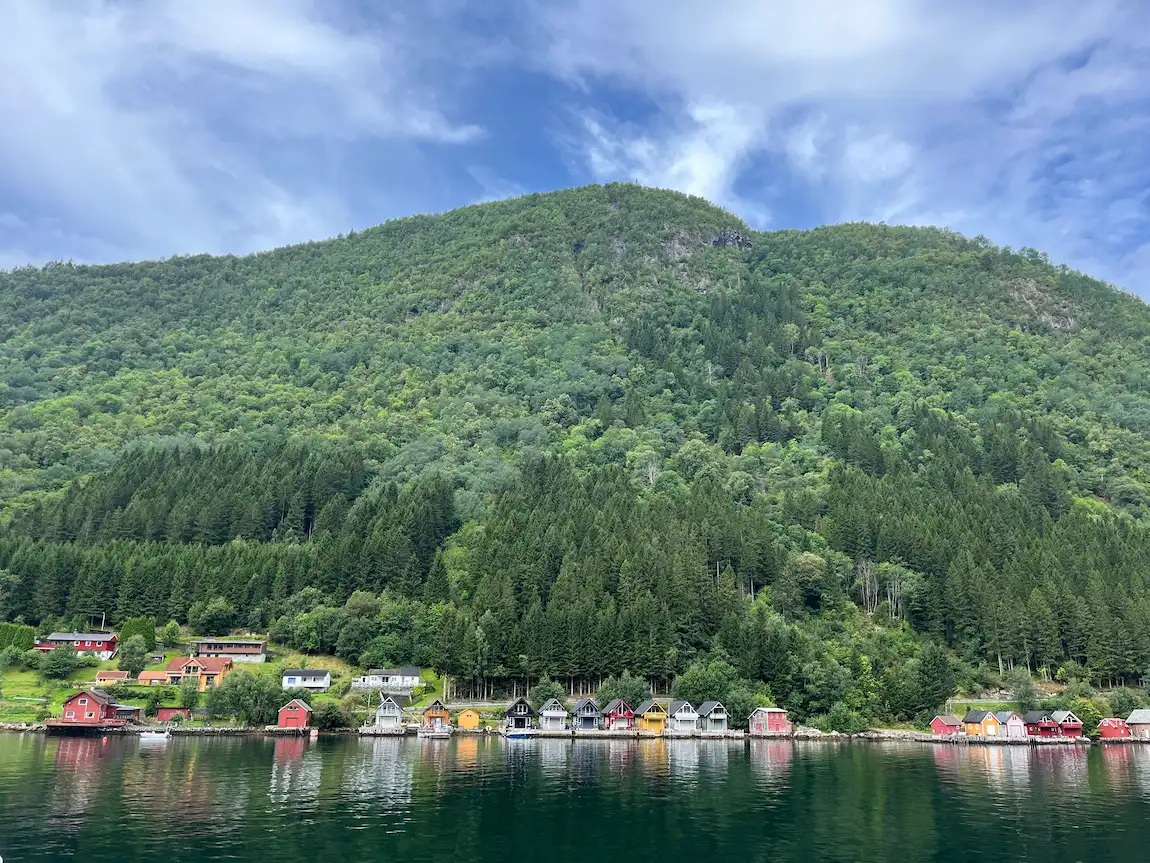Scandinavia with no plane : Explore in low-carbon mode
This summer, we set out to explore Scandinavia with a clear objective: to minimize our carbon footprint. And making this choice means designing your travel differently. Taking your time. By being mindful of your choice of transport and service providers along the way. It’s possible to visit Scandinavia without flying if you consider a low-carbon trip.
But first, why ask about the impact of the trip? The question should be, why don’t we think about it more? Travelling in a more sustainable and responsible way is becoming essential. Tourism accounts for 10% of greenhouse gas emissions , and overtourism threatens natural and historic sites.
Low-impact travel means thinking and designing your trip differently. And that requires a little preparation and the right expectations.
Putting planes and cars aside for sustainable transport
Sustainable travel starts with the question of transport. It often represents 75% of the impact of a trip. Taking into account not only transport from origin to destination, but also all travel during the journey.
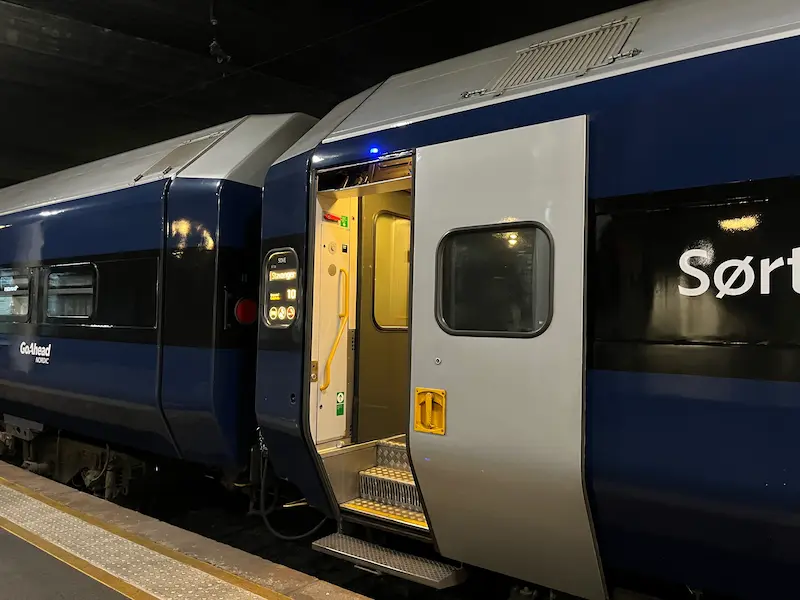
Travelling without a plane or a car can be intimidating. But this invites us to rethink the way we travel. It means accepting a different rhythm, a journey in stages. Consider the geographies we travel through, let ourselves be carried along by the logic of itinerancy, discovering places we might not otherwise have explored. It’s an experience you’ve probably never had before, but one that will leave you with lasting memories.
You need to be aware, however, that getting around will take longer, and plan your trip according to the time you have available. This avoids frustration and disappointment.
That’s why we travel by itinerary. By starting from home and building up an itinerary with stops to cut journey times and explore places along the way.
It’s a trip you wouldn’t make by plane. And that changes everything when it comes to enjoying a trip where we minimize our impact without reducing our potential for wonder.
To visit Scandinavia without flying, you need to plan an itinerary in stages, giving priority to trains, night trains and buses or ferries, depending on the connections you need to make.
Planning a trip to Scandinavia without flying is hard work
We had 3 weeks of vacation available. Reaching Scandinavia was within reach with this comfortable timeframe. But the first and not least important step in a low-carbon journey is to plan your itinerary precisely…
Scandinavia with no plane itinerary, attention to detail
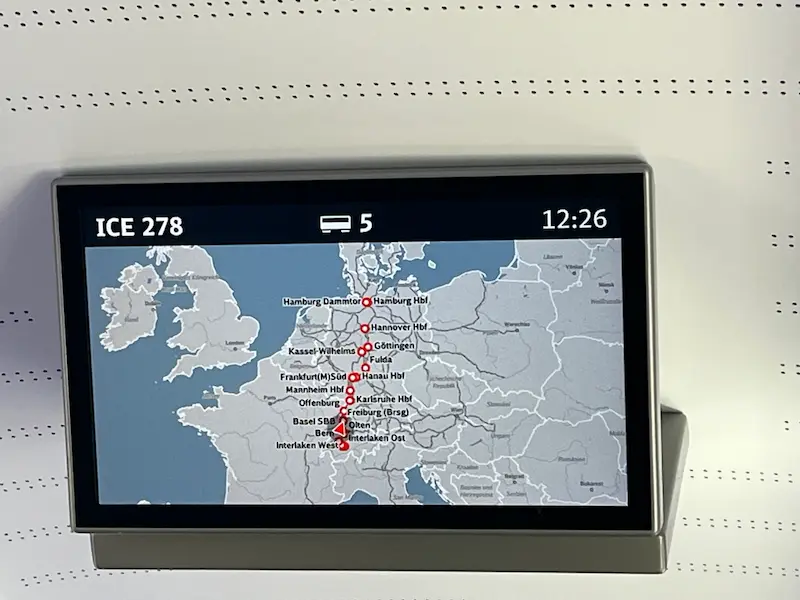
Despite a number of sites that help you plan an itinerary, at the end of the day, there’s no escaping the map, notes and questions stage on travel forums and blogs. Why? Because we often combine transport (train, bus, ferry…) and that’s when everything gets complicated….
In general, the easiest way to do this is to consult the maps that identify night rail links(Back on track). This means long journeys with little impact on travel time.
You can then mix this with players like Trainline or Rome2Rio to check out the intermediate transport proposals. An important piece of advice, however: the best source, especially for train travel, is to go to the operators’ websites. You’ll get the most up-to-date information on offers, fares and timetables. This is not always the case on platforms that do not aggregate all operators. In Europe, there are often different train, bus and ferry companies in each country.
In our case, the most useful part of traveling in Scandinavia without a plane or a car was talking to a traveler. He had already made a similar trip. He recommended night trains and ferry connections to optimize our itinerary…which we wouldn’t have had by consulting the transport platforms.
Optimized connections for worry-free, low-carbon travel
Once you have the outline of your stages, don’t wait to check times and availability. This is especially useful if you take night trains. They can be sold out. You may also find that not all night train or ferry connections are operated every day…and have to do your itinerary all over again. One point not to be overlooked isoptimizing your connections. A five-minute or one-hour connection before a night train is a very bad idea, if you want to be on the safe side.
The key is to take your time and limit the risks. And if you have to wait an hour or two, there’s always time to explore the surrounding area!
The right price
The question of budget is not insignificant, especially if you’re traveling by train. First of all, as in the rest of the transport industry, there are yield management practices. Fares vary according to seat availability and travel period. And here’s the golden rule: anticipation is the best tactic. But there’s another question to ask if you’re taking the train: should you buy single tickets or consider a rail pass?
Well, unfortunately, there’s no easy answer. It depends….
It depends on the country you’re visiting.
When you travel and when you search. Your group (solo, couple, with children).
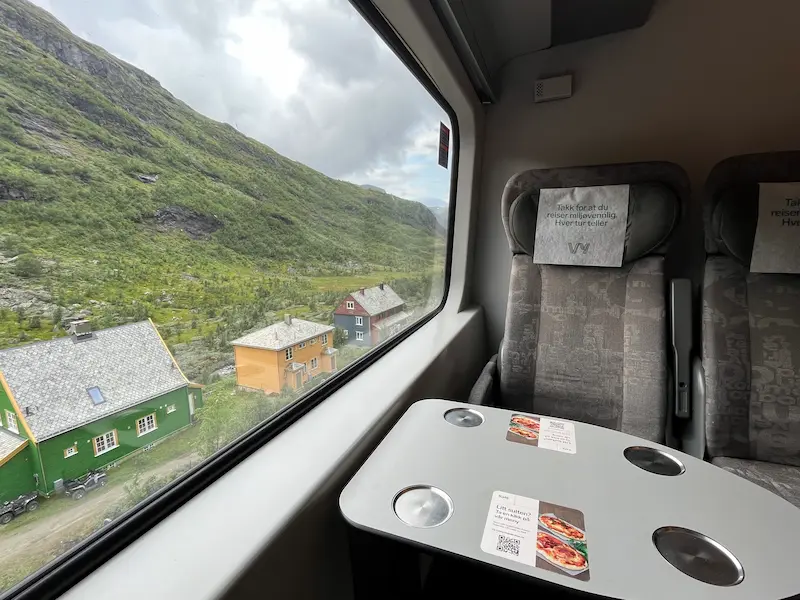
In general, the further east you go in Europe, the less this question arises. Train fares are often very affordable, and infrastructure more uncertain, with many bus alternatives. But for other cases, you need to make a quick comparison or place a bet. In our context, the Interrail pass (Global Pass) was the best option. By booking 1.5 months before departure, we were able to cut transport costs by 50%.
Today, rail passes are being developed by country (Germany, Switzerland, Portugal…). It’s usually worth checking those options before buying individual tickets. It can radically change your travel budget!
Destinations to explore : accessibility and breathing space for a smooth low-carbon journey
Two elements are important when building a low-carbon itinerary:accessibility and the location of stops to create breathing space in the itinerary.
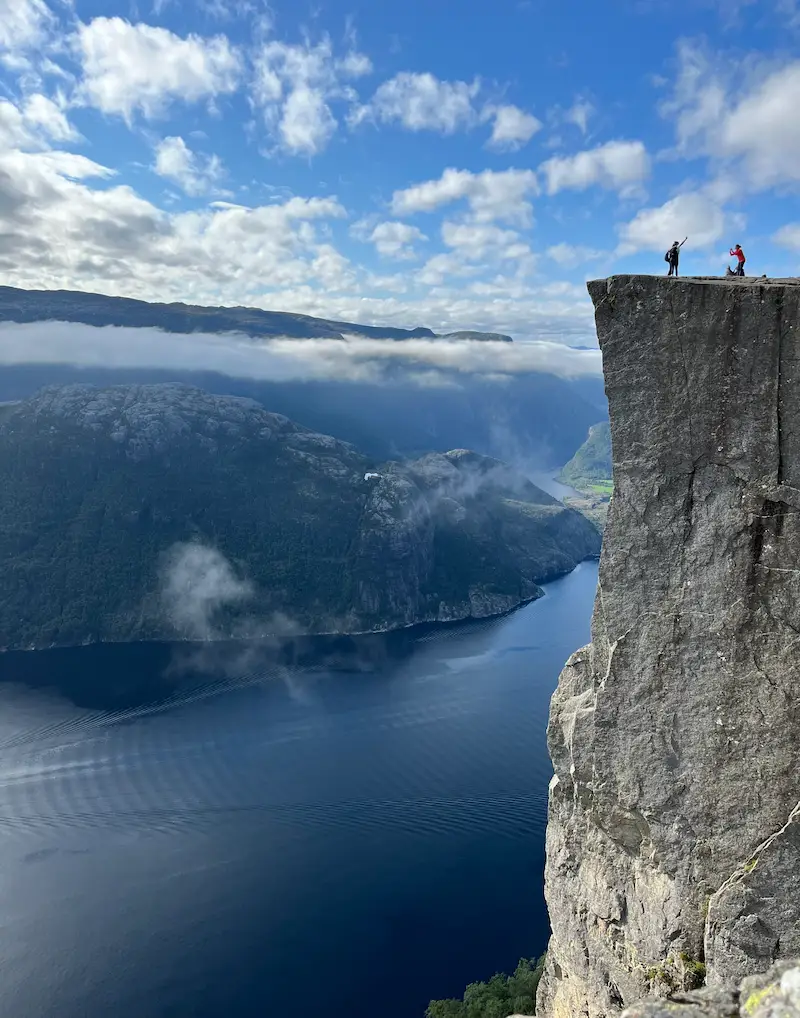
When you’re not leaving for months at a time, the easiest thing to do is to identify well-connected stops by train, bus or boat. If you’re planning to rent an electric car, this criterion is a little less critical (although the question of the network of charging stations needs to be checked), but you do need to ask yourself whether you need a car at all. In many cases, we can do without them.
For this itinerary, for example, we decided to stop in Stavanger. Stavanger is easy to reach by night train from Oslo, making it a great base for exploring the region. Numerous buses serve magnificent hiking sites. It’s possible to stop off in the Preikestolen region to hike without a car, using the buses and staying in a basecamp at the trailheads. (In high season, however, you’ll need to do the hike early in the morning or late in the day if you’re doing the Preikestolen…).
The second criterion for a trip to Scandinavia with no plane is to be able to identify stages that allow you to pace your itinerary andavoid excessively long travel periods. Even if you travel by train, bus or boat, it’s still a long journey, which can be tiring and break the spirit of discovery. Choosing stages that allow you to limit your cumulative travel time will make your experience more pleasant…and your travel time will go almost unnoticed.
Eco-responsible accommodation, activities and restaurants : the other dimensions of low-carbon travel
Have you identified your itinerary and your transport? Now you’re probably wondering about accommodation, activities and restaurants along the way.
Reducing our impact also means choosing sustainable accommodations : those that are more natural, on a human scale, or committed to preserving resources. To find eco-responsible accommodation, you can combine different sources: Booking with its sustainable accommodation criteria (based on the declaration of sustainable practices implemented by accommodation owners), global or local hostel or bed and breakfast platforms (Hostelword, Bed and breakfast), a search on the websites of tourist offices, which are increasingly highlighting this type of service provider….it’s not yet obvious, but the offer and the specialists are developing.
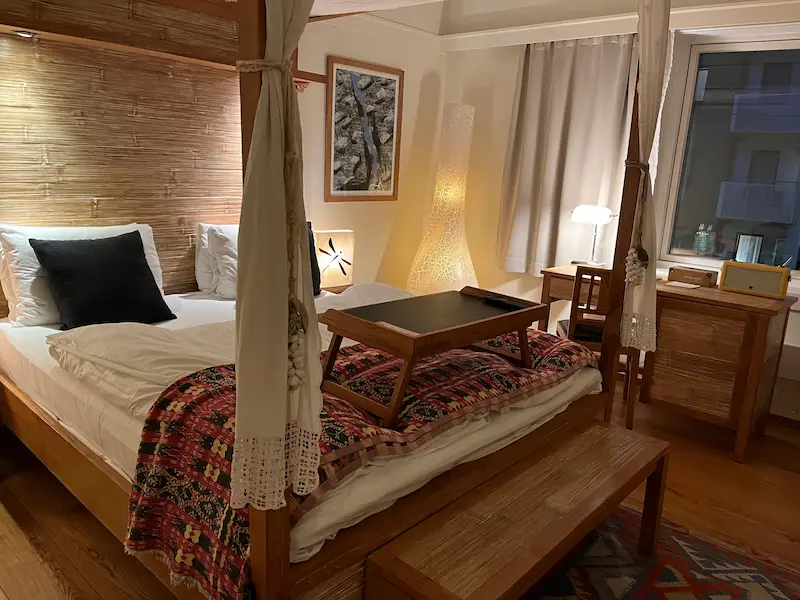
A word of advice when visiting Scandinavia: the cost of living is very high, and chances are you won’t be eating out every day. A good way of looking at it is to have basic equipment for picnics, and to shop at markets and supermarkets for a few more economical meals. It’s also a great way to discover local products and life. So don’t forget your cutlery, a few metal or plastic containers and light bags for your groceries.
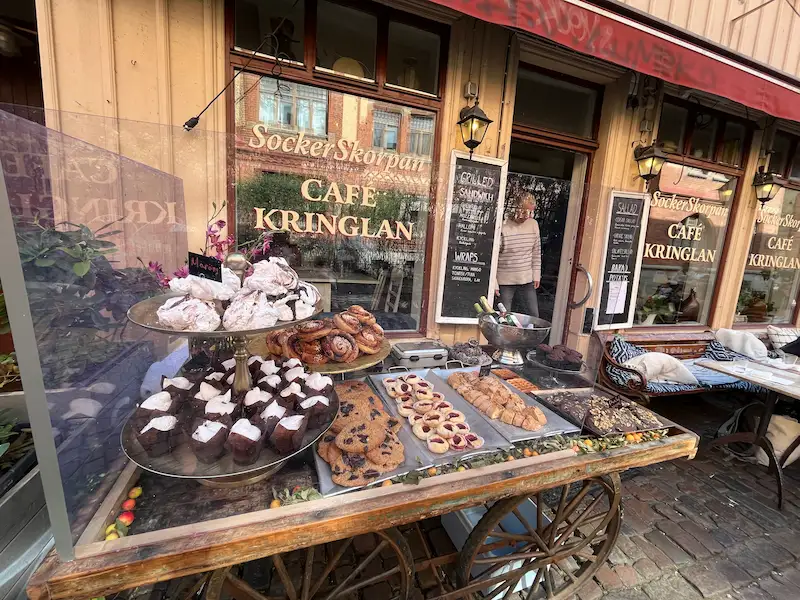
The question of activities and restaurants is one you’ll ask yourself, but probably during your itinerary. This is another recurring field of research during a low-carbon trip. Your travel time will be regularly used to identify activities and search local restaurant spots.
The great thing about Scandinavia is that there are plenty of sustainable activities available, thanks to the majestic natural surroundings. You can easily incorporate eco-friendly activities into your trip, including hiking, biking, kayaking and fjord tours by electric boat. But then again, a little scouting and anticipation can go a long way (!)
3 weeks in Scandinavia with no plane – a low-carbon, peaceful itinerary
What does a three-week low-carbon tour of Scandinavia look like?
It can look like this route with :
a 10-day Interral Global Pass
7 countries crossed
16 trains including 3 night trains, 2 ferries, lots of buses and streetcars for 6,160 kms covered, minimizing its impact. A journey that emits 36 times less CO2 than by plane and 50 times less than by car. With lots of walking and fresh air!
But above all, a lot of curiosity, eye candy and a diversity of landscapes and experiences.
And once you’ve tried it, there’s only one thing left to do : plan your next low-carbon trip.
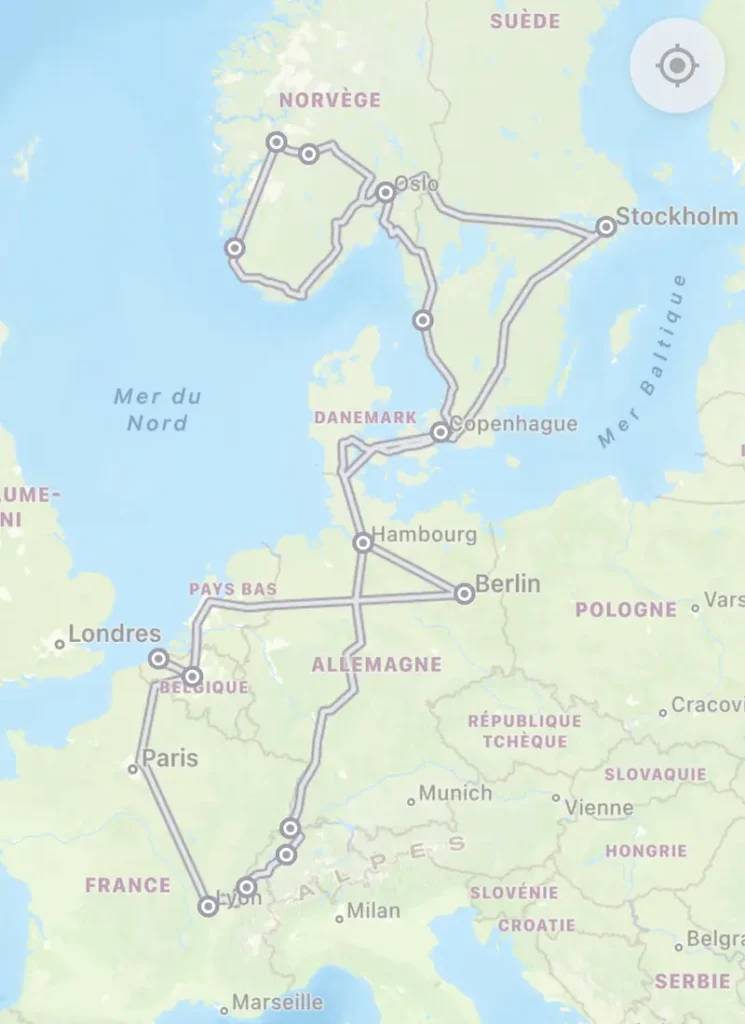
Are you ready to explore Scandinavia in a sustainable way?
If this sounds like something you’d like to do, our teams will be delighted to accompany you on your peaceful, low-carbon journey. Don’t hesitate to get in touch and discover the concept!

